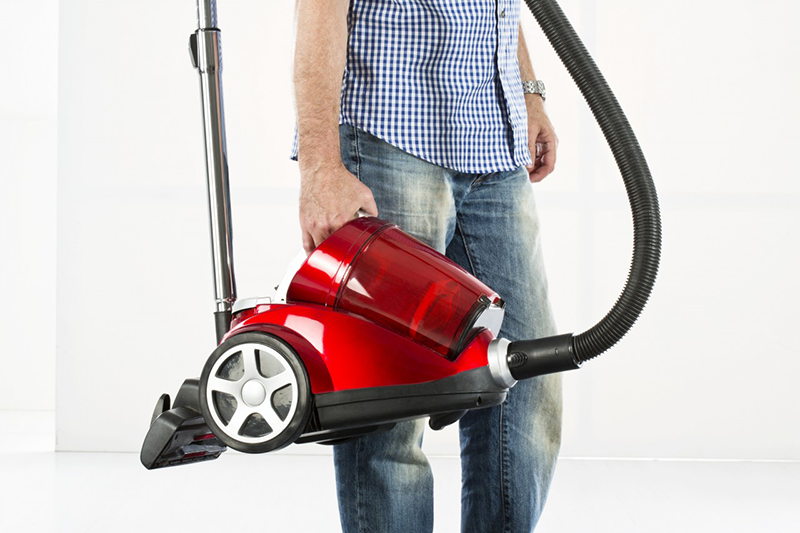Does Your Vacuum Cleaner Stir Up Your Allergies?

Some vacuum cleaners simply spread dust and other allergens around, which really sucks if you have allergies. Here’s how to find the right vacuum — and use it the right way.
Your carpets are teeming with tiny allergy instigators — dust mites, pet dander, and pollen. The obvious solution is to vacuum regularly, but ridding your rugs of allergens isn’t that simple. Sometimes vacuuming can simply spread the sneeze-promoting stuff around your home, inflaming your allergy symptoms even more.
Here are a few tips to finding an allergy-friendly vacuum cleaner and containing carpet dust, dirt, and dander before it can get into the air — and into your nose.
Why vacuuming doesn’t always work
Dust mites, pollen, and pet dander settle on fabrics throughout your home, including on your curtains and bedding. Carpets, with their large surface area, are particularly fertile ground for these allergens.
Vacuuming is one way to suck up dust and dander, but it isn’t always efficient. Sometimes vacuuming simply stirs dust mites around, rather than removing them, according to a study from Woolcock Institute of Medical Research in Australia. In fact, vacuum cleaners can increase levels of dust particles in the air that contribute to allergies, another study found. That’s why it’s important to buy the right model.
Which vacuum cleaners work best
“There are many vacuum cleaners on the market that claim to be suited to allergy sufferers. The most important aspect to look for is HEPA (high efficiency particulate air) filtration which is finding its way into some very affordable models,” said Woolcock allergy researcher, Jason Sercombe. A HEPA filter traps more than 99 percent of the tiniest particles so they can’t get out into the air of your home.
Yet a HEPA filter alone isn’t enough. Vacuum design is important, too. The vacuum should be completely sealed on all sides to prevent any dust particles from escaping. Other features to look for include a rotating brush on the head, which removes more allergens and dirt than other types of heads, and a two- or three-layer bag, which holds in dust better than the one-layered variety.
Some high-tech vacuum cleaner models are UV-C-equipped, meaning they use ultraviolet light to kill dust mites. Are they worth the higher cost? Research finds the technology is twice as effective as traditional vacuums at wiping out infection-causing germs, but whether it works on dust mites isn’t clear.
Before buying a vacuum cleaner, check Consumer Reports or other review sites to see which models scored highest for allergies. This is one purchase where you might want to splurge on a higher-end brand. Research finds newer, more expensive vacuum models emit less pollution than older ones.
Another option is to install a central vacuum. Though pricier than traditional upright models, central vacuums pump dust and dirt outside your home and safely away from your family.
Maintain your vacuum
Simply buying a good vacuum cleaner isn’t enough. You also need to maintain it. Make sure the suction works well. Otherwise, the vacuum will stir up more dust than it takes in. Periodically check that the seals and gaskets are still in good working order. They make the vacuum more efficient. If your vacuum predates much of your furniture, consider replacing it.
Vacuuming basics
Try to vacuum at least once or twice a week. When you do pull out the vacuum, put on a mask. That way, any dust that does get kicked up won’t go into your nose.
Run the vacuum over your carpets several times in a row to make sure you’ve picked up all the tiny particles. It can take as many as eight passes to get your carpets fully clean. Get behind and under furniture, too. Dust mites and pet dander can hide there.
If your vacuum has a bag, empty it when it’s only half-full. The more stuffed the bag becomes, the less air flows through the vacuum and the weaker the suction becomes. Also replace your vacuum’s HEPA filter (if it has one) every six to 12 months.
No matter how high quality your vacuum cleaner is or how often you clean your carpets, you can’t entirely wipe out dust and other allergens. If indoor allergens are still bugging you, your best bet is to pull up the carpets and replace them with hard wood or tile floors.
Updated:
March 30, 2020
Reviewed By:
Janet O’Dell, RN